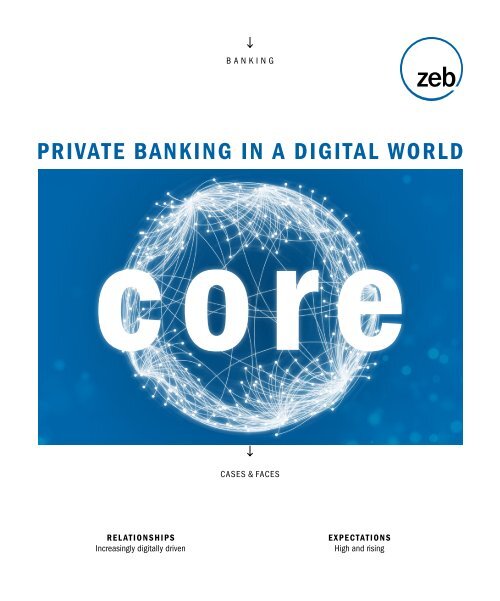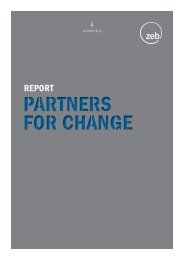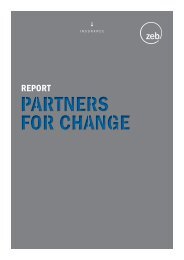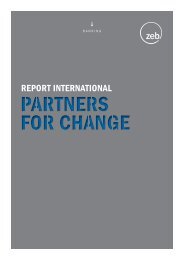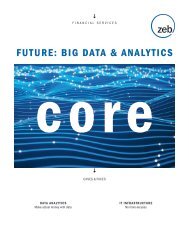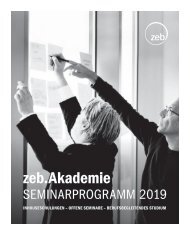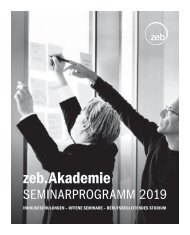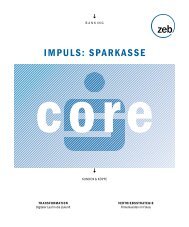core_Private Banking in a digital world_epaper
Create successful ePaper yourself
Turn your PDF publications into a flip-book with our unique Google optimized e-Paper software.
BANKING<br />
PRIVATE BANKING IN A DIGITAL WORLD<br />
CASES & FACES<br />
RELATIONSHIPS<br />
Increas<strong>in</strong>gly <strong>digital</strong>ly driven<br />
EXPECTATIONS<br />
High and ris<strong>in</strong>g
Three perspectives<br />
THE CLIENT PERSPECTIVE<br />
As we move from an analog to a <strong>digital</strong> <strong>world</strong>, relationship management is becom<strong>in</strong>g more<br />
important than ever. It’s time for Relationship Management 4.0.<br />
<strong>Private</strong> bank<strong>in</strong>g clients are demand<strong>in</strong>g that the data they provide is used <strong>in</strong> a smart<br />
fashion for their own benefit. In the near term, client relationship managers<br />
should use <strong>digital</strong>ization and analytics to structure client <strong>in</strong>teractions and anticipate<br />
clients’ needs.<br />
THE REGIONAL PERSPECTIVE<br />
The economy of Greater Ch<strong>in</strong>a has jumped straight from cash payments to mobile-driven<br />
payments. Asian clients are <strong>digital</strong>ly savvy and have high expectations regard<strong>in</strong>g technology—<br />
for private as well as retail bank<strong>in</strong>g.<br />
Innovations <strong>in</strong>clude <strong>digital</strong> onboard<strong>in</strong>g, data aggregation and analytics, virtual communities,<br />
social media, relationship management us<strong>in</strong>g AI-driven avatars, video account<br />
statements and comprehensive e-platforms.<br />
THE FUTURE PERSPECTIVE<br />
Banks should start prepar<strong>in</strong>g as early as possible for long-term <strong>digital</strong> transformation. The<br />
private bank<strong>in</strong>g <strong>world</strong> <strong>in</strong> 2030 will be fundamentally different from what we know today.<br />
Beyond 2030, private bank<strong>in</strong>g will be part of a larger ecosystem. The owner of the<br />
ecosystem will control the client relationship. <strong>Private</strong> banks should already start build<strong>in</strong>g<br />
a safe, protected platform that goes beyond the needs of traditional bank<strong>in</strong>g.
Welcome<br />
to <strong>core</strong><br />
Yet another study of <strong>digital</strong>ization?<br />
You bet! Digital transformation is about to shake the <strong>world</strong> of<br />
private bank<strong>in</strong>g to its very <strong>core</strong>. This is a level of disturbance<br />
that it would be foolish to ignore.<br />
The multitude of <strong>in</strong>novations and new technologies appear<strong>in</strong>g<br />
on the scene have many private bankers and wealth managers<br />
scratch<strong>in</strong>g their heads. Where should they start and what is<br />
really relevant for private bank<strong>in</strong>g? How should they deal with<br />
facial recognition, mobile payments or roboadvisors? And what<br />
about <strong>digital</strong> transformation, big data/data analytics or mach<strong>in</strong>e<br />
learn<strong>in</strong>g/AI? Or PSD2, blockcha<strong>in</strong> or cryptocurrencies?<br />
To help <strong>in</strong>dustry professionals navigate the road ahead, we<br />
exam<strong>in</strong>e the <strong>world</strong> of private bank<strong>in</strong>g and wealth management<br />
from three different perspectives. The first is a client perspective.<br />
What do clients really want? What are exist<strong>in</strong>g clients<br />
look<strong>in</strong>g for, and what will make potential clients choose you<br />
rather than your competitors? Our answers are based on an<br />
extensive survey of more than 100 private bank<strong>in</strong>g clients <strong>in</strong><br />
Germany, Austria and Switzerland.<br />
Next, we take a regional perspective. What’s go<strong>in</strong>g on <strong>in</strong> private<br />
bank<strong>in</strong>g and wealth management <strong>in</strong> technology-forward Asia? To<br />
answer this question, we carried out more than 20 extensive<br />
<strong>in</strong>terviews with <strong>in</strong>dustry <strong>in</strong>siders <strong>in</strong> S<strong>in</strong>gapore and Greater Ch<strong>in</strong>a.<br />
F<strong>in</strong>ally, we take a future perspective. Where do we go from<br />
here? What are the implications for the immediate period after<br />
2019, and for the long-term for the period after 2030? Here,<br />
we draw on our <strong>in</strong>-house knowledge and our understand<strong>in</strong>g of<br />
the <strong>in</strong>dustry based on <strong>in</strong>-depth analysis and our work support<strong>in</strong>g<br />
clients. We also provide our recommendations for how private<br />
banks can prepare themselves for the future.<br />
The follow<strong>in</strong>g pages conta<strong>in</strong> a series of bite-sized morsels,<br />
designed to whet your appetite for more. Along the way, we<br />
take a brief glance at the topic of “roboadvisors”: could these<br />
<strong>digital</strong> <strong>in</strong>vestment mach<strong>in</strong>es solve the cost issues associated<br />
with provid<strong>in</strong>g clients with face-to-face advice, or is their true<br />
role elsewhere <strong>in</strong> the <strong>in</strong>vestment ecosystem?<br />
We also <strong>in</strong>clude highlights from an <strong>in</strong>terview with Thomas<br />
Allemann, Head of Digitalization, International Wealth<br />
Management at Credit Suisse, for some first-hand <strong>in</strong>dustry<br />
<strong>in</strong>sights.<br />
Welcome to the <strong>digital</strong> <strong>world</strong>, a <strong>world</strong> full of hidden potholes<br />
and unexpected turns <strong>in</strong> the road. Jo<strong>in</strong> us <strong>in</strong> our search to get<br />
to the <strong>core</strong> of the issue.<br />
Contact<br />
Axel Oliver Sarnitz, Partner<br />
asarnitz@zeb.de<br />
Norman J. Karrer, Partner<br />
norman.karrer@zeb.ch<br />
PRIVATE BANKING IN A DIGITAL WORLD<br />
3
Perspective 1:<br />
What do clients want?<br />
Meet<strong>in</strong>g clients’ needs is the key rationale beh<strong>in</strong>d any bus<strong>in</strong>ess model.<br />
That’s as true for private bank<strong>in</strong>g as it is for the automotive or <strong>in</strong>surance<br />
<strong>in</strong>dustries. But to meet clients’ needs, you first need to know what<br />
those needs are. What is it that exist<strong>in</strong>g clients and new client types are<br />
look<strong>in</strong>g for? And what motivates potential clients to choose you over<br />
your competitors?<br />
PRIVATE BANKING IN A DIGITAL WORLD<br />
4<br />
n the second half of 2017, zeb carried out an extensive<br />
survey of private bank<strong>in</strong>g clients. We spoke to more than<br />
100 clients <strong>in</strong> Germany, Austria, Switzerland and Greece.<br />
Interview participants <strong>in</strong>cluded both high net worth<br />
<strong>in</strong>dividuals (HNWIs) and ultra high net worth <strong>in</strong>dividuals<br />
(UHNWIs).<br />
We discovered that these clients have three different types<br />
of needs. First, they have functional needs, such as the need<br />
for specialist knowledge of real estate, appropriate products,<br />
good value for money and accessibility. Second, they have<br />
emotional needs, such as the need for a sparr<strong>in</strong>g partner, a<br />
strong reputation on the part of the bank, and services such as<br />
lifestyle consult<strong>in</strong>g and wealth preservation. Third, they have<br />
personal needs, such as the requirement for a trustworthy<br />
contact person at the bank, <strong>in</strong>heritance services or the ability<br />
of the bank to save them time.<br />
Which of these needs are most significant for clients? We<br />
found that needs of the emotional and personal type were<br />
consistently ranked above functional needs. In other words,<br />
the quality of services offered and the image of the bank are<br />
more important than the actual <strong>in</strong>vestment returns and the<br />
bank’s range of products.<br />
Top of the pyramid of needs, however, comes time relief—the<br />
ability of the bank to save clients time. Time is the most precious<br />
asset for HNWIs and UHNWIs. In the words of American<br />
entrepreneur Jim Rohn: “Time is more valuable than money.<br />
You can get more money, but unfortunately you can’t get<br />
more time.”<br />
KEEP IT SAFE<br />
So, wealthy clients don’t care if they get lousy returns on their<br />
money? They do—but their priority is to see that their wealth<br />
is preserved. Performance is not as important as preservation.<br />
Keep their money safe, save them time, provide them with<br />
“comprehensive services” and a trustworthy personal contact<br />
and be always available and reliable, and the chances are that<br />
the client will be yours for life.<br />
The problem? Such a bus<strong>in</strong>ess model is costly for banks. That<br />
has led private banks to search for solutions such as <strong>digital</strong><br />
transformation, standardization of offer<strong>in</strong>gs or the provision of
PYRAMID OF NEEDS: TIME<br />
RELIEF ON TOP OF IT ALL<br />
Reliev<strong>in</strong>g time stra<strong>in</strong><br />
Personal and emotional<br />
Succession<br />
plann<strong>in</strong>g<br />
Proactive<br />
support<br />
Reputation<br />
Life cycle advice<br />
Asset<br />
preservation<br />
Functional<br />
Availability<br />
Digital<br />
offers<br />
Performance<br />
Sparr<strong>in</strong>g<br />
Expertise<br />
Process<strong>in</strong>g<br />
Price<br />
F<strong>in</strong>ancial<br />
concierge<br />
Product<br />
range<br />
Low importance<br />
High importance<br />
more automated advise for the affluent client segment through<br />
roboadvisors—automated plattforms that provide <strong>in</strong>vestment<br />
advice based on algorithms. But most private bank<strong>in</strong>g clients, as<br />
we see <strong>in</strong> the box on roboadvisors on page 6, are not really sold<br />
on this impersonal touch.<br />
CAPTURING THE NEW GENERATION<br />
And there’s more. The current bus<strong>in</strong>ess model <strong>in</strong> private bank<strong>in</strong>g<br />
and wealth management relies on exist<strong>in</strong>g clients. Today’s private<br />
bank<strong>in</strong>g clients <strong>in</strong> Germany, Austria and Switzerland are on<br />
average 65 years old or over and are fairly <strong>digital</strong>ly literate, with<br />
70 percent of them enjoy<strong>in</strong>g daily access to the Internet. They<br />
represent EUR 17 trillion <strong>in</strong> <strong>in</strong>heritance through 2050. And there<br />
will be 40 million <strong>in</strong>heritors <strong>in</strong> that same period, 40 percent of<br />
whom will belong to Generations X and Y, that is, born between<br />
the mid-1960s and the mid-1990s. This future generation of<br />
private bank<strong>in</strong>g clients has greater <strong>digital</strong> aff<strong>in</strong>ity, and banks will<br />
need to make a concerted effort to acquire them. Failure to do<br />
so could result <strong>in</strong> an outflow of more than 80 percent of assets.<br />
but tomorrow’s <strong>digital</strong>ly-m<strong>in</strong>ded <strong>in</strong>heritors. Acquir<strong>in</strong>g these<br />
<strong>in</strong>heritors later on will be very challeng<strong>in</strong>g, especially if one of<br />
your competitors has built a more convenient or more secure<br />
<strong>digital</strong> platform. Action is needed today to secure the bus<strong>in</strong>ess<br />
of tomorrow.<br />
Contact<br />
Markus Bräckle, Senior Manager<br />
mbraeckle@zeb.de<br />
PRIVATE BANKING IN A DIGITAL WORLD<br />
As we move <strong>in</strong>to the <strong>digital</strong> age, private bank<strong>in</strong>g providers<br />
must look at what clients need—not just today’s wealthy clients<br />
5
BANKING<br />
BANKING<br />
PRIVATE BANKING IN GERMANY AND AUSTRIA<br />
In November 2018 we published a major study with a focus on private bank<strong>in</strong>g <strong>in</strong> Austria and Germany. Germany<br />
is the second-largest private bank<strong>in</strong>g market <strong>in</strong> Europe measured by liquid funds. For the purposes of the study,<br />
we not only spoke with relationship managers from various <strong>in</strong>stitutions and looked at their <strong>in</strong>come figures, we also<br />
<strong>in</strong>terviewed the k<strong>in</strong>d of wealthy clients that private bank<strong>in</strong>g deals with. It gave us <strong>in</strong>-depth <strong>in</strong>sights <strong>in</strong>to client wishes<br />
and demands, while clients were pleased to provide help and happy about the <strong>in</strong>terest taken. That gave us one of<br />
the <strong>core</strong> statements of the study: speak to your clients, get to know them, sound them out and f<strong>in</strong>d out what they<br />
expect from your bank. This will greatly improve advisory quality and accord<strong>in</strong>gly client satisfaction.<br />
zeb.<strong>Private</strong> <strong>Bank<strong>in</strong>g</strong> Study<br />
Germany 2018<br />
zeb.<strong>Private</strong>-<strong>Bank<strong>in</strong>g</strong>-Studie<br />
Österreich 2018<br />
WEGE, UM BEWÄHRTES ZU BEWAHREN<br />
zeb.<strong>Private</strong> <strong>Bank<strong>in</strong>g</strong> Study: Germany 2018<br />
zeb.<strong>Private</strong> <strong>Bank<strong>in</strong>g</strong> Study: Austria 2018<br />
are available on www.bank<strong>in</strong>ghub.de<br />
zeb.<strong>Private</strong> <strong>Bank<strong>in</strong>g</strong> Study: Switzerland 2019<br />
(com<strong>in</strong>g soon)<br />
PRIVATE BANKING IN A DIGITAL WORLD<br />
ROBO OR NO-GO?<br />
Provid<strong>in</strong>g private bank<strong>in</strong>g clients with personal, face-to-face advice is an expensive bus<strong>in</strong>ess. To reduce these<br />
costs, and to better serve <strong>digital</strong>ly focused clients, some private banks have <strong>in</strong>troduced (for their affluent<br />
segment) “roboadvisors”—<strong>digital</strong> offer<strong>in</strong>gs provid<strong>in</strong>g automated <strong>in</strong>vestment management on the basis of<br />
mathematical rules or algorithms, with little or no human <strong>in</strong>volvement. But although surf<strong>in</strong>g the f<strong>in</strong>tech wave<br />
<strong>in</strong> this way is certa<strong>in</strong>ly an attractive proposition for banks, it has proved less appeal<strong>in</strong>g to typical wealth<br />
management clients. These clients value personal contact with a trusted private bank<strong>in</strong>g advisor who can offer<br />
them tailored advice.<br />
One possible role for roboadvisors would be as an additional offer<strong>in</strong>g <strong>in</strong> the discretionary mandate space<br />
sold via relationship managers. They may also be suitable as a mechanism for acquir<strong>in</strong>g younger clients who<br />
have smaller amounts to <strong>in</strong>vest. These clients are not yet wealthy enough to fall <strong>in</strong>to the typical target group<br />
for private bank<strong>in</strong>g but they may <strong>in</strong>herit <strong>in</strong> the future. As the cost base of roboadvisors is much lower than<br />
traditional face-to-face advisors, private banks can use them to address these clients—<strong>in</strong> the hope that when<br />
they <strong>in</strong>herit, they will rema<strong>in</strong> loyal to the bank and move on to more sophisticated services.<br />
6
Perspective 2:<br />
What’s go<strong>in</strong>g on <strong>in</strong> Asia?<br />
Asia is known for be<strong>in</strong>g technology-forward and <strong>in</strong>novation-rich. What<br />
trends are currently shap<strong>in</strong>g private bank<strong>in</strong>g and wealth management<br />
<strong>in</strong> S<strong>in</strong>gapore and Greater Ch<strong>in</strong>a? Can these countries show us the way<br />
forward <strong>in</strong> Europe?<br />
sian clients have high expectations when it comes<br />
to technology. In particular, Ch<strong>in</strong>a has jumped straight<br />
from cash payments to mobile-driven payments,<br />
leapfrogg<strong>in</strong>g card-driven payments entirely. Innovation<br />
is common here <strong>in</strong> both retail and private bank<strong>in</strong>g, and players<br />
who want to know what lies ahead <strong>in</strong> the private bank<strong>in</strong>g<br />
<strong>in</strong>dustry would do well to look to the East.<br />
To f<strong>in</strong>d out more, we <strong>in</strong>terviewed around 20 wealth management<br />
professionals <strong>in</strong> S<strong>in</strong>gapore and Greater Ch<strong>in</strong>a. We found that<br />
lead<strong>in</strong>g private banks are busy us<strong>in</strong>g artificial <strong>in</strong>telligence and<br />
build<strong>in</strong>g their own platforms and networks. Digital <strong>in</strong>novations<br />
<strong>in</strong>clude data aggregation and analytics, virtual communities,<br />
social media, relationship management us<strong>in</strong>g avatars and comprehensive<br />
e-platforms.<br />
But th<strong>in</strong>gs are far from straightforward for private banks. High<br />
net-worth <strong>in</strong>dividuals (HNWIs) <strong>in</strong> Asia typically have relationships<br />
with between three and six different banks, entrust<strong>in</strong>g<br />
around 15–30 percent of their assets to each. For banks, this<br />
means that 70 to 85 percent of a client’s assets are held with<br />
another bank or outside of the bank<strong>in</strong>g system altogether.<br />
Individual banks lack an overview of their clients’ total wealth<br />
situation and so have little traction when it comes to offer<strong>in</strong>g<br />
them private bank<strong>in</strong>g services.<br />
One company us<strong>in</strong>g <strong>in</strong>novative <strong>digital</strong> technology to master<br />
these challenges we had the chance to talk to was a large <strong>in</strong>ternational<br />
bank. It has a strong presence on social media such<br />
as Instagram. This attracts attention and allows the company<br />
to communicate with current and potential clients, particularly<br />
social media native millenials. Also, the bank was present on<br />
WeChat, the Ch<strong>in</strong>ese messag<strong>in</strong>g, social media and mobile<br />
payment app, which offers open APIs that companies can use<br />
to build custom features and <strong>in</strong>teract with clients. In the area of<br />
transactions and services, report<strong>in</strong>g statements were additionally<br />
provided <strong>in</strong> the form of short 2-m<strong>in</strong>ute video files, focus<strong>in</strong>g on<br />
very few KPIs that are key for the client. In terms of relationship<br />
management, another player employs artificial <strong>in</strong>telligence-driven<br />
avatars of special topic experts that <strong>in</strong>teract with the bank’s<br />
clients via video chat.<br />
Contact<br />
Laura Pfannemüller, Manager<br />
lpfannemueller@zeb.de<br />
PRIVATE BANKING IN A DIGITAL WORLD<br />
7
Perspective 3:<br />
Where do we go from here?<br />
<strong>Private</strong> bankers and wealth managers want to know what's go<strong>in</strong>g on<br />
right now, but they also need to know what lies around the corner—and<br />
beyond. We use our knowledge of the <strong>in</strong>dustry to shed some light on<br />
the near and long-term future.<br />
PRIVATE BANKING IN A DIGITAL WORLD<br />
8<br />
2019+<br />
What are the short-term implications for the <strong>digital</strong> transformation<br />
of private bank<strong>in</strong>g? We believe that, as we move from an<br />
analog to a <strong>digital</strong> <strong>world</strong>, relationship management will still play<br />
a central role <strong>in</strong> wealth management and private bank<strong>in</strong>g. In the<br />
early years after 2018, we will f<strong>in</strong>d ourselves <strong>in</strong> a comb<strong>in</strong>ation of<br />
analog and <strong>digital</strong> <strong>world</strong>s. The analog <strong>world</strong>, with its traditional<br />
face-to-face meet<strong>in</strong>gs and telephone calls, will <strong>in</strong>creas<strong>in</strong>gly give<br />
way to the <strong>digital</strong> <strong>world</strong> of e-mails, websites, mobile applications<br />
and social media. But client management will rema<strong>in</strong> at the<br />
heart of both.<br />
In response to these developments, private banks and relationship<br />
managers need to start us<strong>in</strong>g <strong>digital</strong>ization and data<br />
analytics to structure their client <strong>in</strong>teractions and anticipate the<br />
needs of current and future clients. Digitalization is a means to<br />
get closer to your clients, not to keep them at a distance. Banks<br />
can achieve this by collect<strong>in</strong>g and analyz<strong>in</strong>g personal data and<br />
data from client transactions, social media, the press, faceto-face<br />
meet<strong>in</strong>gs and so on, and us<strong>in</strong>g it to anticipate client<br />
life events. They can then recommend products, actions and<br />
services on this basis.<br />
Two examples: the relationship manager receives a notification<br />
from their AI-supported CRM tool that Client X is expect<strong>in</strong>g<br />
a child. The relationship manager sends a congratulatory message<br />
via the bank-<strong>in</strong>ternal chat system, along with some <strong>in</strong>formation<br />
about tax schemes and relevant <strong>in</strong>vestment products,<br />
such as a securities account for the newborn, that can be<br />
purchased right <strong>in</strong> the chat system. Client Y is due to retire <strong>in</strong><br />
the com<strong>in</strong>g year, accord<strong>in</strong>g to <strong>in</strong>formation <strong>in</strong> the press, which<br />
the relationship manager was <strong>in</strong>formed about by the tool.<br />
This is confirmed <strong>in</strong> a personal meet<strong>in</strong>g between the relationship<br />
manager and the client. The relationship manager then<br />
presents the client with personalized visual <strong>in</strong>formation about<br />
future liquidity development as well as f<strong>in</strong>ancial management<br />
options <strong>in</strong> retirement. In both cases, the bank has ascerta<strong>in</strong>ed<br />
<strong>in</strong> advance the client’s preferred communication channel and<br />
<strong>in</strong>vestor profile by collect<strong>in</strong>g and analyz<strong>in</strong>g their data.<br />
RELATIONSHIP MANAGEMENT 4.0<br />
A catchy name, but what does it entail? On the one hand,<br />
we have the bank<strong>in</strong>g ecosystem: products and services such<br />
as wealth management, asset management and <strong>in</strong>vestment<br />
bank<strong>in</strong>g. On the other, we have the client ecosystem: clients’<br />
life stages and needs, from <strong>in</strong>herit<strong>in</strong>g assets and purchas<strong>in</strong>g<br />
real estate to wealth preservation and lifestyle consult<strong>in</strong>g.<br />
The future relationship between these two ecosystems will<br />
make use of traditional analog connections such as personal<br />
meet<strong>in</strong>gs and phone calls, but also—and <strong>in</strong>creas<strong>in</strong>gly—<strong>digital</strong>
Customer data analysis<br />
Phone<br />
Personal Events<br />
Analog <strong>world</strong><br />
Customer data analysis<br />
Customer ecosystem<br />
Relationship<br />
Management<br />
4.0<br />
Bank ecosystem<br />
Customer relationship management<br />
E-mail<br />
Onl<strong>in</strong>e<br />
Digital <strong>world</strong><br />
PB portal<br />
Social<br />
media<br />
Digital<br />
processes<br />
Mobile<br />
connections such as social media, private bank<strong>in</strong>g websites<br />
and apps. Technological advances open the door for broader<br />
<strong>digital</strong> <strong>in</strong>novation, from AI-driven avatars to video account<br />
statements. This transformation will be driven by client data<br />
analysis, and accompanied by the <strong>digital</strong>ization of bank<br />
processes.<br />
2030 AND BEYOND—ONE VERSION OF THE FUTURE<br />
Of course, nobody has a crystal ball to see far <strong>in</strong>to the future.<br />
Nevertheless, we try to def<strong>in</strong>e a possible scenario based on our<br />
understand<strong>in</strong>g and <strong>in</strong>sights <strong>in</strong>to the market.<br />
Beyond 2030, private bank<strong>in</strong>g will form part of a larger ecosystem.<br />
The owner of the ecosystem will control the client relationship.<br />
Personal advisors will only be used for special cases and<br />
large volumes, while m<strong>in</strong>or questions will be handled by virtual<br />
advisors. The daily management of liquidity and simple <strong>in</strong>vestments<br />
will be done to a large extent by algorithms.<br />
We expect to see today’s retail and affluent segments merg<strong>in</strong>g<br />
<strong>in</strong>to a fully-<strong>digital</strong>, lower-priced offer<strong>in</strong>g, with personal advisory<br />
available as high-priced private bank<strong>in</strong>g and wealth management.<br />
Clients will be able to choose themselves which model<br />
suits them best. Today’s private bank<strong>in</strong>g bus<strong>in</strong>ess model will<br />
vanish along with today’s older-generation clients.<br />
How can private banks prepare themselves for this new <strong>world</strong>?<br />
Players should start now build<strong>in</strong>g safe, protected platforms and<br />
also ecosystems that go beyond the needs of classical bank<strong>in</strong>g.<br />
Once they have established a platform, they can then gradually<br />
broaden it by add<strong>in</strong>g useful value-added services for clients.<br />
The possibilities for expansion are almost unlimited, rang<strong>in</strong>g<br />
from <strong>in</strong>surance and education to communities, health, employment<br />
and beyond.<br />
Contact<br />
Kerst<strong>in</strong> Schneider, Senior Consultant<br />
kerst<strong>in</strong>.schneider@zeb.de<br />
PRIVATE BANKING IN A DIGITAL WORLD<br />
9
The view from the <strong>in</strong>side<br />
Thomas Allemann heads Digitalization at Credit Suisse’s International<br />
Wealth Management (IWM) division. Based <strong>in</strong> Zurich, he is responsible<br />
for driv<strong>in</strong>g the design and development of a unified, <strong>digital</strong> front-toback<br />
client and client advisors eco-system.<br />
PRIVATE BANKING IN A DIGITAL WORLD<br />
10<br />
What is your assessment of <strong>digital</strong>ization <strong>in</strong> the private bank<strong>in</strong>g <strong>in</strong>dustry?<br />
THOMAS ALLEMANN: The F<strong>in</strong>ancial Services <strong>in</strong>dustry, <strong>in</strong>clud<strong>in</strong>g Wealth Management, was and is—to a large<br />
extent—already digitized. In our <strong>in</strong>dustry we do not produce and deliver physical goods with costly logistics. In<br />
our case it is all about process<strong>in</strong>g numbers and trust. Our <strong>in</strong>dustry, therefore, has not yet experienced the<br />
vast disruption caused by <strong>digital</strong>ization as witnessed <strong>in</strong> other <strong>in</strong>dustries, such as <strong>in</strong> retail shopp<strong>in</strong>g, media &<br />
enterta<strong>in</strong>ment or <strong>in</strong> travel or transportation. In these <strong>in</strong>dustries disruption has impacted the whole value cha<strong>in</strong><br />
and even forced big names out of bus<strong>in</strong>ess (or relegated them to niche markets). The <strong>digital</strong> <strong>in</strong>novation we<br />
have seen so far <strong>in</strong> our <strong>in</strong>dustry is simply to do th<strong>in</strong>gs better, faster and at a lower cost. But this is not really<br />
disruptive. This is not where we will see fundamental change. We are however learn<strong>in</strong>g a lot from other<br />
<strong>in</strong>dustries, such as from Silicon Valley companies, <strong>in</strong> terms of how they deal with and learn about clients.<br />
“Uber” is a good example of a company with a sharp focus on how to make life easier for their clients. The<br />
service they offer is very specific but at the same time they make sure the client receives the service it needs<br />
and wants with the desired quality and an opportunity to provide immediate feedback. Not that customers<br />
should rate every <strong>in</strong>teraction they have with their bank immediately, but we could take a page out of their<br />
book. And f<strong>in</strong>ally, not only is pure <strong>digital</strong>ization hav<strong>in</strong>g an impact, but these pure-<strong>digital</strong> bus<strong>in</strong>ess models are<br />
now add<strong>in</strong>g non-<strong>digital</strong> bus<strong>in</strong>ess to their portfolios. For example, to name just a few, Amazon buy<strong>in</strong>g<br />
thousands of e-scooters (later drones) to take over delivery services and also choos<strong>in</strong>g to open brick and<br />
mortar retail branches; Facebook, pay<strong>in</strong>g over a billion US dollars to produce/acquire television/broadcast<br />
content and Airbnb construct<strong>in</strong>g their own apartment blocks and hotels. We are witness<strong>in</strong>g a merger of the<br />
non-<strong>digital</strong> with the <strong>digital</strong> <strong>world</strong> as the <strong>digital</strong> <strong>world</strong> opts to hold real assets. This means they start hav<strong>in</strong>g<br />
similar operational risks and need to adhere to similar regulatory frameworks as the non-<strong>digital</strong> <strong>world</strong>.<br />
What is your view on the key priorities a private bank needs to have now? In the near future?<br />
THOMAS ALLEMANN: The key priority for a bus<strong>in</strong>ess should always be the client. This is especially of importance<br />
to Wealth Management s<strong>in</strong>ce the foundation of our bus<strong>in</strong>ess is based on our client relationships.<br />
However, this is not a fixed relationship; clients and their needs change, they disrupt. In fact the <strong>core</strong><br />
disruptive and transformative force is the (prospective) client. As a consequence, we have to be truly client<br />
centric and adapt or proactively adapt accord<strong>in</strong>gly. This means we, more so than <strong>in</strong> other <strong>in</strong>dustries, need<br />
to cont<strong>in</strong>uously develop our services and solutions and pursue a transformational culture that satisfies the<br />
needs and desires of our clients. A good example of this is the transfer of wealth to the next generation.
Millennials, the largest generation s<strong>in</strong>ce the baby boomers, will start to <strong>in</strong>herit wealth. We have to make<br />
sure our offer<strong>in</strong>g and our services cater to the needs and desires of this new generation. As a bank, we<br />
focus on help<strong>in</strong>g this generation to understand how to approach <strong>in</strong>vestment decisions; facilitat<strong>in</strong>g conversations<br />
around it and enabl<strong>in</strong>g them to be more comfortable <strong>in</strong> their role as heirs, <strong>in</strong>vestors and bus<strong>in</strong>ess<br />
drivers. Mov<strong>in</strong>g forward, we cont<strong>in</strong>ue to focus on embedd<strong>in</strong>g client fac<strong>in</strong>g technology with<strong>in</strong> our client<br />
centricity, us<strong>in</strong>g <strong>digital</strong> <strong>in</strong>novation to deliver even more personalized and <strong>in</strong>sightful services to clients when,<br />
where and how they want it.<br />
What does private bank<strong>in</strong>g 2019+ at CS look like regard<strong>in</strong>g <strong>digital</strong>ization (<strong>in</strong>novative offer<strong>in</strong>gs)?<br />
THOMAS ALLEMANN: We are focus<strong>in</strong>g on the extension of the most relevant <strong>digital</strong> capabilities and work on<br />
solutions to achieve a competitive edge at the <strong>core</strong> of our value proposition. Let me outl<strong>in</strong>e the most important<br />
examples: a) automated portfolio rebalanc<strong>in</strong>g, <strong>in</strong>vestment opportunity spott<strong>in</strong>g and trade/<strong>in</strong>vestment<br />
proposal generation <strong>in</strong> advisory; b) fully automated E2E workflows <strong>in</strong> <strong>core</strong> processes of the Wealth Management<br />
value cha<strong>in</strong>, i.e. <strong>in</strong> client onboard<strong>in</strong>g; c) <strong>digital</strong> client collaboration and communication tools across all<br />
<strong>digital</strong> channels; d) big data and AI driv<strong>in</strong>g client analytics, content management and <strong>in</strong>vestment research to<br />
fully satisfy customized client needs.<br />
What is CS’s op<strong>in</strong>ion of RoboAdvice?<br />
THOMAS ALLEMANN: The highest segment of the wealth pyramid is a key part of our client base. The f<strong>in</strong>ancial<br />
demands and needs of our clients <strong>in</strong> this segment are quite complex. For example, they look at wealth<br />
plann<strong>in</strong>g across generations and often require <strong>in</strong>tegrated solutions across private bank<strong>in</strong>g and <strong>in</strong>vestment<br />
bank<strong>in</strong>g that cover their professional as well as personal wealth needs. These demands cannot be serviced<br />
solely by an automated platform propos<strong>in</strong>g and execut<strong>in</strong>g <strong>in</strong>vestment decisions. “Robo-advisors” today<br />
have two key limitations <strong>in</strong> servic<strong>in</strong>g such private bank<strong>in</strong>g clients. Firstly, they apply algorithms to create<br />
mostly ETF-based portfolios. This is highly efficient but cannot accommodate the complex f<strong>in</strong>ancial needs<br />
of a sophisticated private bank<strong>in</strong>g client. Secondly, their reach and offer<strong>in</strong>g is primarily local, whereas<br />
many of our private bank<strong>in</strong>g clients have global needs. We believe a <strong>core</strong> part of our value proposition to<br />
our clients, of all wealth segments, is that we understand them as <strong>in</strong>dividuals. We have relationships built on<br />
shared experiences and trust, and while <strong>digital</strong> can enhance this relationship, it will not replace it anytime<br />
soon. Furthermore, relationship managers today also take on the role of a network and capabilities orchestrator.<br />
They need to f<strong>in</strong>d and deliver highly complex solutions, provide holistic advice via different networks<br />
and specialists whether <strong>in</strong> <strong>in</strong>vestment bank<strong>in</strong>g, asset management or trad<strong>in</strong>g solutions; manag<strong>in</strong>g assets<br />
and liability needs of our mostly entrepreneurial clients. We have been <strong>in</strong>vest<strong>in</strong>g <strong>in</strong> technology and tra<strong>in</strong><strong>in</strong>g<br />
to ensure that our relationship managers are equipped with the right tools and networks to help them<br />
guide their clients <strong>in</strong> mak<strong>in</strong>g their <strong>in</strong>vestment decisions.<br />
What do you th<strong>in</strong>k will be the key changes ahead?<br />
THOMAS ALLEMANN: I expect our organization will cont<strong>in</strong>ue to change at an <strong>in</strong>creas<strong>in</strong>g pace. For example,<br />
bus<strong>in</strong>esses and technology are com<strong>in</strong>g even closer together. There is “no bus<strong>in</strong>ess here and IT there”<br />
anymore. We are also transform<strong>in</strong>g more and more <strong>in</strong>to a “project”-centric organization. And we are also<br />
chang<strong>in</strong>g the “modus operandi”: mov<strong>in</strong>g away from a static, goal sett<strong>in</strong>g, plann<strong>in</strong>g and execution process<br />
(“waterfall”) to a more dynamic environment where bus<strong>in</strong>ess requirements and solutions evolve through<br />
the collaborative effort of self-organiz<strong>in</strong>g and cross-functional teams alongside their clients or end user(s).<br />
This new environment advocates adaptive plann<strong>in</strong>g, evolutionary development, early delivery, and cont<strong>in</strong>ual<br />
improvement, and it encourages rapid and flexible response to change. This is called “agility”.<br />
PRIVATE BANKING IN A DIGITAL WORLD<br />
11
“Time is more valuable than<br />
money. You can get more<br />
money, but unfortunately you<br />
can’t get more time.”<br />
Jim Rohn, American entrepreneur<br />
LINK TO E-PAPER<br />
WWW.ZEB.EU/CORE/PRIVATE_BANKING<br />
Publisher zeb.rolfes.schierenbeck.associates gmbh, Hammer Straße 165, 48153 Münster, Germany, www.zeb.eu<br />
Contacts Axel Oliver Sarnitz, Partner, Taunusanlage 19, 60325 Frankfurt, Germany, e-mail: asarnitz@zeb.de, Norman J. Karrer, Partner, Gutenbergstrasse 1, 8002 Zurich,<br />
Switzerland, e-mail: norman.karrer@zeb.ch, Daniel Crow, Senior Manager, 107 Cheapside, EC2V 6DN London, UK, e-mail: daniel.crow@zeb.co.uk<br />
Editor Market<strong>in</strong>g & Communications, e-mail: publications@zeb.eu<br />
This publication has been prepared for general guidance only and does not take <strong>in</strong>to account the reader’s <strong>in</strong>dividual <strong>in</strong>vestment objectives or risk tolerance. The reader should not<br />
act accord<strong>in</strong>g to any <strong>in</strong>formation provided <strong>in</strong> this publication without receiv<strong>in</strong>g specific professional advice. zeb rsa GmbH shall not be liable for any damages result<strong>in</strong>g from<br />
any use of the <strong>in</strong>formation <strong>in</strong> the publication. No part of this document may be reproduced or copied <strong>in</strong> any form or by any means without written permission from zeb.<br />
@zeb rsa GmbH. ALL RIGHTS RESERVED.


